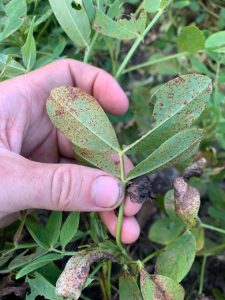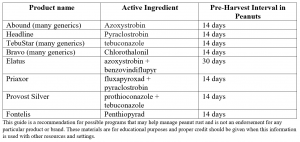Jay Capasso, UF/IFAS Columbia County Extension. Nicholas Dufault, University of Florida Plant Pathology Department.
Introduction:
Peanut rust (Puccinia arachidis Speg.) is considered an “explosive” peanut foliar disease. Initial symptoms include orange dots or pustules on the bottom side of the leaves (image 1). Recent rainy and windy weather have provided optimal conditions for peanut rust to spread. Unlike leaf spot diseases, where the leaves die and fall off the plant, peanut rust causes the leaves to die and hang on allowing the disease to spread rapidly through the canopy. In the 2020 season, peanut rust was first reported in Georgia during the month of August, but was not identified in Florida until the beginning of September in Columbia County. Soon after it was observed in Florida’s Suwannee and Gadsden Counties. Peanut rust is not believed to survive the winter in North Florida or Georgia, meaning it is likely blown into the peanut production region from South Florida or the Caribbean.

Management:
Due to peanut rust not being very common in Florida or the Southeast, the efficacy of many fungicide products is not well known throughout the region. However, many fungicide products we spray to prevent leaf spot and white mold also have activity against peanut rust. Suppressing peanut rust will require more frequent fungicide applications than what is necessary for leaf spot, meaning the interval between applications should be shortened. Dr. Nicholas Dufault of University of Florida’s plant pathology department recommends use of azoxystrobin (e.g. Abound) and pyraclostrobin (Headline) for managing peanut rust based on research from 2014. Other products such as chlrorothalonil (e.g. Bravo) and tebuconazole (e.g. Tebustar) also have activity against peanut rust. Only the active ingredients chlorothalonil and pyraclostrobin provide adequate activity against both peanut rust and late leaf spot. Farmers spraying the new leaf spot fungicide Miravis should mix in a product that has additional activity against peanut rust. It is important to understand that once peanut rust, or any disease, has been identified in your field that fungicide products will only slow the spread and not eliminate the disease. Thus, environment and peanut maturity are important to consider when planning your peanut rust management plan.
Since peanut rust appeared late in the season it is worth considering the presence of the disease, vine health of the crop, days after planting, and pod blasting when determining digging date. If growers decide to spray a fungicide to suppress peanut rust the pre-harvest interval of the product should be considered. Most products containing activity against peanut rust have a pre-harvest interval of 14 days. However, the least risky option, for fields with late season peanut rust, will be to dig at the most optimally mature stage possible before vine health deteriorates.

For more information on peanut rust see link below:
http://nwdistrict.ifas.ufl.edu/phag/2020/09/04/the-what-when-and-how-of-floridas-peanut-rust-issue/
 0
0
